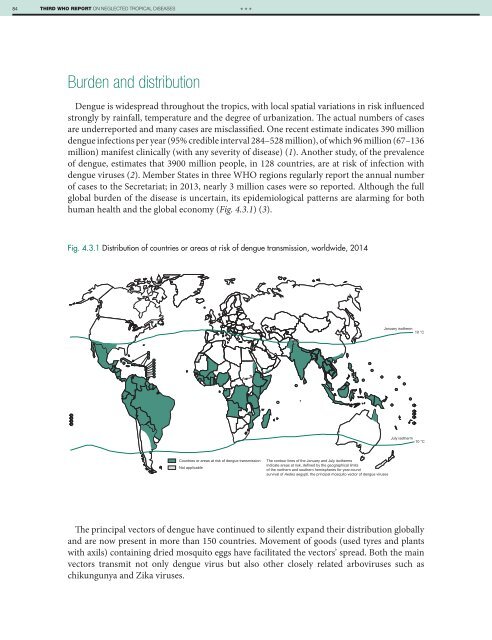1A9bnbK
1A9bnbK
1A9bnbK
You also want an ePaper? Increase the reach of your titles
YUMPU automatically turns print PDFs into web optimized ePapers that Google loves.
84 THIRD WHO REPORT ON NEGLECTED TROPICAL DISEASES<br />
***<br />
Burden and distribution<br />
Dengue is widespread throughout the tropics, with local spatial variations in risk influenced<br />
strongly by rainfall, temperature and the degree of urbanization. The actual numbers of cases<br />
are underreported and many cases are misclassified. One recent estimate indicates 390 million<br />
dengue infections per year (95% credible interval 284–528 million), of which 96 million (67–136<br />
million) manifest clinically (with any severity of disease) (1). Another study, of the prevalence<br />
of dengue, estimates that 3900 million people, in 128 countries, are at risk of infection with<br />
dengue viruses (2). Member States in three WHO regions regularly report the annual number<br />
of cases to the Secretariat; in 2013, nearly 3 million cases were so reported. Although the full<br />
global burden of the disease is uncertain, its epidemiological patterns are alarming for both<br />
human health and the global economy (Fig. 4.3.1) (3).<br />
Fig. 4.3.1 Distribution of countries or areas at risk of dengue transmission, worldwide, 2014<br />
January isotherm<br />
10 °C<br />
July isotherm<br />
10 °C<br />
Countries or areas at risk of dengue transmission<br />
Not applicable<br />
The contour lines of the January and July isotherms<br />
indicate areas at risk, defined by the geographical limits<br />
of the northern and southern hemispheres for year-round<br />
survival of Aedes aegypti, the principal mosquito vector of dengue viruses<br />
The principal vectors of dengue have continued to silently expand their distribution globally<br />
and are now present in more than 150 countries. Movement of goods (used tyres and plants<br />
with axils) containing dried mosquito eggs have facilitated the vectors’ spread. Both the main<br />
vectors transmit not only dengue virus but also other closely related arboviruses such as<br />
chikungunya and Zika viruses.


